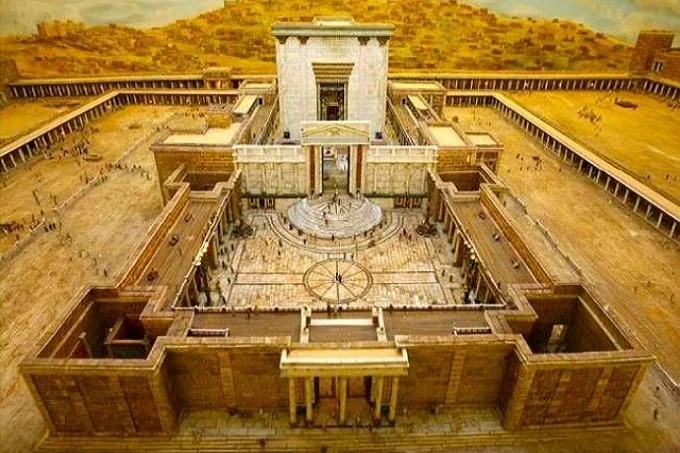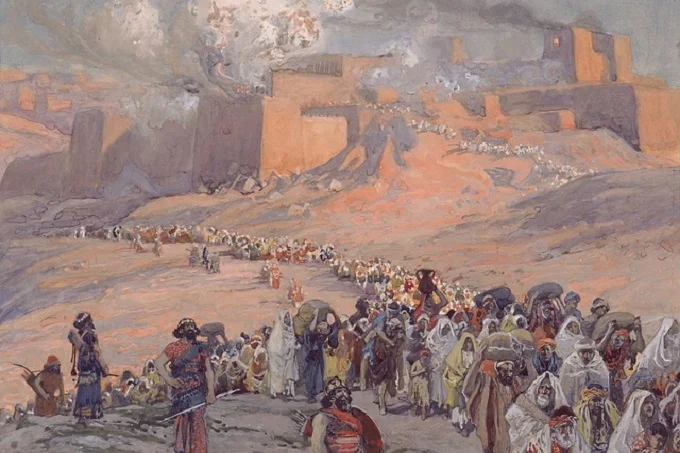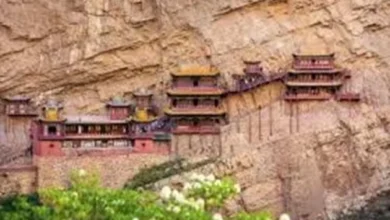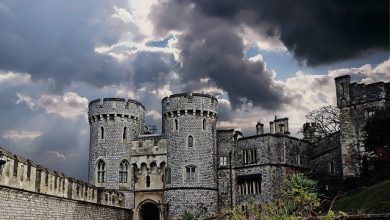The temple of King Solomon

Although King Solomon built the First Temple in Jerusalem, preparations for its construction were begun in the previous reign. King David purchased a place for the Temple, made extensive preparations for building materials, drew up a plan for the Temple, and saved money.
Jerusalem at that time was much smaller than today, of its four hills, only one was inhabited — Mount Zion. After the occupation of the city, David surrounded it with a wall. A rather high Mount Moriah adjoined Zion on the east side. It was occupied by the field of a local resident, Jebusei Orna. In the middle of the field, on the upper ridge of the mountain, a threshing floor was arranged. King David bought this mountain from Orna for 50 shekels of silver (according to other sources, for 600 shekels of gold). It is quite possible that the mountain was bought in parts: first, a small part of it for 50 shekels of silver, and then other areas adjacent to it — for only 600 shekels of gold.
After acquiring the place, David immediately consecrated it with the creation of an altar. According to history, this was the very place where Abraham was preparing to sacrifice his son Isaac.
The building material prepared by King David for the Temple is gold, silver (although it is not mentioned in the decoration of Solomon’s Temple), copper, precious stones, iron, cedar beams, marble, stone. The Jerusalem Temple was the only one for the entire kingdom of Israel and therefore required all kinds of splendor.
David fulfilled the plan of the Temple in general and in particular, which he handed over to his heirs in a solemn will and with an insistent demand to fulfill it.
Despite the multitude of building materials prepared by David, it was not enough even to start work, especially there were few stones and a construction tree. Therefore, King Solomon, starting the construction of the Temple, concluded an agreement with King Hiram of Tyre, according to which he undertook to supply Solomon with cedar and cypress wood, hewn ready-made stones from the Lebanese mountains; the cutting down of the timber and the processing of stones should be provided to the people sent by Solomon, but for guidance to put over them also Phoenician craftsmen, as more experienced in the business, wooden beams should be delivered from Lebanon by sea on rafts to Jaffa, the nearest pier to Jerusalem. For his part, Solomon had to supply wheat, wine, and oil to Tyre. There is evidence that King Solomon concluded a similar agreement with the Egyptian king.
No axe, hammer, or other iron tool was heard at the Temple’s construction site: wood and stone finishing works were carried out in Lebanon, and foundry work was carried out in the Jordan Valley.
Before proceeding with the construction of the Temple, it was necessary to find a place for it corresponding to the plan. In its original form, the ridge of Mount Moriah was very steep, it could barely accommodate the body of the Temple and the altar. There was no place at all for the courtyards that were supposed to surround the Temple from all sides.
In addition, in its original direction, the ridge of the mountain. It went diagonally – not directly from north to south, but from northwest to southeast. And the Temple and its courtyards had to be clearly oriented (like a tabernacle) in the right relation to the four cardinal directions.
Therefore, in preparation for the construction of the Temple, it was required: a) to expand the upper part of the mountain to the dimensions provided for by the Temple plan, b) to change or align the direction of the ridge so that the area prepared for the Temple was, perhaps, more accurately facing the four cardinal directions.
And King Solomon came up with a wise plan: to build on the eastern side of the mountain, starting from its sole, among the Kedron Valley passing here, a large and solid stone wall in the direction that the wall of the Temple courtyard should have (that is, directly from north to south), and fill the gap between the wall and the slope of the mountain with earth.
In general, the Temple of Solomon was built according to the plan given for the tabernacle of Moses, only in large sizes and with those adaptations that were necessary for a rich immobile sanctuary. The Temple was divided into the Holy of Holies, the sanctuary, and the vestibule, but it was larger and more magnificent than the tabernacle. Around the inner compartment of Solomon’s Temple, a large area was arranged — compartments for the people (or a large courtyard). The second courtyard, or the court of the priests, was twice the size of the tabernacle. Accordingly, the washbasin of the tabernacle at the altar of the Temple had a whole system of ablution vessels: 10 artistically made washbasins on stands and a large pool for water, called the sea by its size, the vestibule of the Temple was a corridor 20 cubits long (the width of the Temple body) and 10 cubits deep. Two large copper pillars stood in front of it.
The internal size of the Temple was partially doubled, partially tripled by the size of the tabernacle.
The Holy of Holies and the sanctuary were separated by a stone wall with an olive tree door. The walls of the Temple itself were laid out of massive hewn stone, lined with white marble on the outside, but, like the doors of the tabernacle, they were covered with wooden lining inside, and then they were also lined with gold leaf. The doors, the ceiling, and the cypress floor of the Temple were also covered with gold.
Figures of the same cherubim were depicted on the walls of the tabernacle as on the embroidered veil that draped its inner walls. And cherubim were depicted on the walls of the Temple of Solomon, only an ornament in the form of plants was added. Externally, the appearance of the Temple was striking in its grandeur, massiveness, and strength, and inside – wealth and splendor, unheard of even in the ancient world, the entire interior of the Temple was lined with wood – the walls and ceiling with cedar, and the floor with cypress, so that the stone inside the Temple was not visible. The wallboards were decorated with carvings of reliefs cut inwards (rather than protruding forward), the deeply carved main subjects of the paintings never stood out above the wall plane.
The paintings again depicted figures of cherubs, but to them were added images of palm trees, (a kind of wild cucumbers) and blooming flowers. The choice of a palm tree is explained not only by the fact that it was the most beautiful and useful tree – a symbol of beauty, greatness, and moral perfection.
According to the ancients, the birthplace of the palm was Palestine, from where it spread throughout the ancient East. The palm tree in the Jerusalem Temple was a symbol of the triumph of God in the promised land. There were no images of the palm tree in the tabernacle since it was a sanctuary of the desert, built only on the way to Palestine.
The wooden boards covering the stone walls (bars in the windows, ceiling, floor, steps leading to the Holy of Holies), in turn, were covered with gold leaf.
Each nail with which the gold sheets were nailed was also gold. There were also multicolored gems for decoration on the gold. In its external forms, the Temple resembled a ship expanding to the top, or Noah’s Ark. The inner platforms towering one above the other came out from the lower main part of the walls and three ledges. These projections required special supports, which were three rows of columns with the fourth row of cedar pilasters. Thus, colonnades (or covered alleys) were formed along the three walls of the Temple (north, south, and west) under the wide canopies of the wall protruding in the upper parts.
When the Temple was ready, King Solomon called all the elders and many people to consecrate it. Then, with the sound of trumpets and the singing of spiritual songs, the Ark of the Covenant was brought in and placed in the Holy of Holies under the overshadowing of two new colossal cherubim, who stretched out their wings so that the ends of the outer wings touched the wall, and the inner wings bent over the Ark. The glory of the Lord in the form of a cloud filled the Temple, so that the priests could not continue the service. Then Solomon ascended to his royal seat, fell on his knees, and began to pray to God that He would accept the prayers of not only the Israelites, but also the Gentiles in this place. At the end of this prayer, fire descended from heaven and scorched the sacrifices prepared in the Temple.
The Babylonian king Nebuchadnezzar captured Jerusalem, plundered it, burned and destroyed the Temple of Solomon to the ground. At the same time, the Ark of the Covenant perished. The entire Jewish people were taken captive (589 BC), only the poorest Jews were left on their land to cultivate vineyards and fields. In the destroyed Jerusalem, the prophet Jeremiah remained, who wept on the ruins of the city and continued to teach the good of the remaining inhabitants.

The Jews were in Babylonian captivity for 70 years. The Persian king Cyrus, in the first year of his rule over Babylon, allowed the Jews to return to their homeland. Such prolonged captivity led them to realize that only the Temple of Jehovah could stand Jerusalem and the entire Jewish kingdom. This conviction was so firm in them that they left Babylon only after securing royal permission to build a Temple in Jerusalem again.
Forty-two thousand Jews went to their land. Those who remained in Babylon helped them with gold, silver, and other property, and moreover with rich donations to the Temple. The king gave the Jews the sacred vessels that Nebuchadnezzar took from the Temple of Solomon.
Returning to Jerusalem, the Jews first restored the altar to the Lord God, and the next year laid the foundation of the Temple. Nineteen years later, the construction of the Temple was completed. The new Temple was not as rich and magnificent as the Temple of Solomon, and the elders, who remembered the splendor of the former Temple, wept that the Second Temple was poorer and smaller than the previous one.
But in the reign of Herod (37-4 BC), who put a lot of effort into its expansion and decoration, the Temple reached a special flourishing and splendor. Josephus left the following description of the Temple: “The Temple shone so brightly, reflecting the sun’s rays that no one could look at it. And from a distance, it looked like a mountain peak sparkling with snow. The terraces of the Temple consisted of huge granite blocks up to 20 meters long. These stone blocks were carefully fitted to each other so that they would not be moved even by an earthquake.




